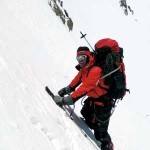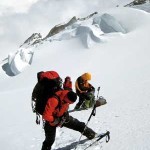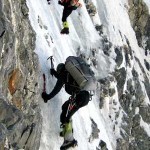Victory and Tragedy on Nanga Parbat
Linked by our will to get to the top of the Couloir, we were completely detached from success or failure, movement becoming the only thing that mattered.
The Picture and the Bottle of Schnapps
At the end of August 2007, I was walking with Austrian friends Günther Unterberger and Gerfried Göschl on the Baltoro glacier in Northern Pakistan. Our legs could not take another week of climbing and our stomachs were tired of dal, rice and chapattis. It was time to go home, although after summiting Broad Peak and two attempts on K2, we wanted more. Crossing Concordia, we searched for the next project. We don’t know who came up first with Nanga Parbat idea for 2009, but as soon as we came home, we began our homework. The objective was finding a completely new route on Nanga Parbat. For a year, we analyzed every picture, book and map, exchanging countless e-mails with ideas.
In spring 2008, Gerfried found a possible route to an untouched part of Nanga Parbat’s Northwest wall in Reinhold Messner´s book Alleingang am Nanga Parbat, (published in English as Solo: Nanga Parbat). Messner’s incredible picture of Nanga shows the complete Diamir flank from the sky. The key to the puzzle was a hidden couloir between the Czech route, on the right side, and the incomplete Diamar glacier route, on the left side. It was a secret way to join the untouched Northwest buttress. On paper, this line was perfect and we wanted to climb it alpine style.
We assembled the team in 2008. We needed one group on the Kinshofer (normal route), and one small team for the new route (Gerfried, Gunther, Hans Goger and myself). The organization was easy because it was almost the same friends from our 2007 Broad Peak – K2 trip, plus some new faces. Six other members went directly to K2, and some others planned to give K2 a try after Nanga Parbat. We arrived in Pakistan on June 12th. After an approach of three days, we reached base camp on June 17th.
We acclimatized until July 3, and then we were ready to step into the unknown, except for one last thing. During our acclimatization, a member of the Kinshofer team, Sepp Bachmair wanted to join our team of four to attempt the new route. Adding a fifth member could change our strategy. Like boys deciding whether another kid can join their secret club, we talked until late that night in the tent, finally agreeing that we had more chances of success by adding Sepp, who could help us with trail breaking and other problems. We immediately awoke Sepp and invited him in the tent to tell him that he could come with us. He wanted to drink a bottle of schnapps right away as his initiation. All five of us drank all night to celebrate and review our upcoming project. It was memorable.
A Walk in the Park
We packed everything until late the night before our departure. We plan for 5 1/2 days on the mountain. Hans and I would share a two-man tent and Gerfried, Gunther and Sepp a three-person tent. We also brought three ice screws, two pitons and 50m of 7mm static rope.
We started at 8 a.m. from base camp, and at Camp One on the Kinshofer, picked up our climbing gear. Next we followed the base of the North West wall to find a safe way onto the glacier. Except for some threatening hanging seracs, we found a very safe route all along the base. In less than two hours, we were standing right in front of our couloir. It was really a walk in the park. We made our first bivouac at 5,300 m and after dinner, we looked at what was in store the next morning: the couloir. The anxiety was palpable.
Five Heavy Packs
We started at 7:30 a.m.. Thankfully, the couloir wasn’t exposed to sun until midday. The snow was very firm and we decided to hit the slope on the left side. We easily crossed the bergschrund and it began to get steep, with sections up to 50 degrees for 150 m and a 20 m, 80 degree step. Gerfried, Gunther and Hans decided to traverse left onto rock and avoid the near-vertical blue ice. Sepp and I went right up it. Everyone stepped out of this first technical section with more confidence. Step by step, and with every swing of our tools, unroped but linked by our will to get to the top of the couloir, we were completely detached from success or failure, movement becoming the only thing that mattered.
A 60 to 65 degree blue ice section, covered by two inches of soft snow turned out to be the crux. Normally, it wouldn’t have been difficult, but high wind and snowfall started when I began to lead the first pitch. Two more 50 m pitches and long minutes of wind, snow and numb hands followed. We topped out on the Rousseau Ice Wall in the sun, everybody smiling, happy to have completed the first ascent of the 800 m Göschl Couloir. Our second bivouac was at around 6,400m.
A Guarded Col
Thinking we could allow ourselves some rest, we decided to leave a little later on the third day. There were no clouds and we could see the whole Diamir valley. Right in front of us two immense pinnacles, showing Nanga Parbat’s gargantuan scale, blocked our access to the col above.
The terrain was magnificent. A small plateau angled towards the first pinnacle. Under the col, an enormous serac protruded from the slope like an eternal ice guardian of the forbidden col. It looked very stable and its strange shape beckoned us. We named it the Bachmair Serac, in honour of Sepp.
We kept going left and reached what we later named the Kölblinger Col. The next part on the ridge was generally easy, but going around the crevasses made it tedious. The last section before our third bivouac (6,900 m) was a long slope that reached a small plateau, the Goger Plateau. Since the beginning, Nanga Parbat’s summit pyramid could not be seen. It had been strange to climb without seeing the summit; it felt like we were climbing solely for the pleasure of the movement, without any real goal.
The Unterberger traverse
When we awoke on the fourth day, we could see below us a few lower summits that looked like tiny islands in an infinite sea of clouds. Looking toward the horizon, we could not distinguish cloud from snow. The dreadful long slope above us led to the upper part of the northwest buttress. It was time for trail breaking but luckily, snow conditions were good and all five of us worked well.
At the end of morning, we reached steep rock. The wind blew hard and cold, so I decided to climb in my down jacket. Sometimes we were separated because of poor visibility. Gerfried and Günther were in front of me when they suddenly stopped. When I reached them, Gerfried was holding the Diamir picture from Messner’s book. He explained that our best chance was to traverse at 7,250 m. On the picture, we could see a way to reach the basin of Camp Four on the Kinshofer route. The route above us was too technical for 7,000 m and we only had two rock pitons. Reaching Camp Four might improve our chance of success.
Günther began trail breaking. Below us was a 2,000 m abyss; this was the most horrifying part of our route. The snow was soft and deep with no chance to self-arrest if we fell. It was Hans’s turn to lead when we reached a tiny ledge. When we joined Hans, we stepped forward to see what was on the other side. It was the impressive summit pyramid of Nanga Parbat. Down below, we could see minuscule yellow, red and blue dots; it was camp 4 (7100m). We made it! We all screamed and laughed and suddenly people came out of their tents; it was our Kinshofer route team partners coming back from their summit attempt. I shed some tears on my descent to Camp Four, realizing what we had just accomplished.
Our friends welcomed us with big hugs and smiles; they couldn’t believe we popped out of nowhere. It had been an amazing climb.We were lucky with the conditions, teamwork, the route was nearly as we planned it and the difficulties were exactly as we thought they would be. It was not a tremendous epic climb, it was a memorable, just-hard-enough Himalayan climbing experience. At least until our summit push.
A Race into the Death Zone
We tried to rest for the final effort. Our plan was to start at 1 a.m., so we needed to wake up at 11 p.m., to gear up and melt snow water. Around 9 p.m., Gerfried received a distress call from Base camp. The Koreans, who were climbing one day before us, with the rest of our normal route team, were in trouble after making the summit at 7 p.m. in bad weather. Go Mi-Sun, a top female Korean climber, was at the limit of exhaustion. She was climbing with five or six other Korean team members and Wolfgang Kölblinger. They were the only ones left on the summit pyramid on the July 10 attempt. Wolfgang was one of our teammates and had climbed Broad Peak with us in 2007 and he was one of Gerfried’s family friends.
When we got the news, we started preparing to assist the Koreans. We had had no news from Wolfgang for two hours, but we thought he was with the Koreans and had problems with his radio. Skies were clear and winds were low as we started slowly to keep our energy. Günther, definitely one of the strongest among us on the new route, suffered problems with altitude and had to return to Camp Four. Right at the base of the pyramid, Gerfried and I came across Miss Go and the rest of the Korean team. We asked if they needed assistance but they said that they had recovered. They said they hadn’t seen Wolfgang since the summit.
Gerfried and I rushed towards the summit, hoping to find our friend. We were now thinking that he had made a bivouac on his descent. Unfortunately, we found that he fell to his death below the summit. After realizing the hopelessness of the situation, we proceeded the few metres to the summit. We discovered his backpack and ice axe at 8064m, and after following the track of a falling body in the snow, we found his hat at 8016m. He must have fallen more than 2,000 m. Some days later, a helicopter couldn’t find any sign of him.
I took Wolfgang’s pack to Camp Four. We met Sepp and Hans on the way to the summit. Around 7,800 m Gerfried sat down, shed some tears and phoned his wife in Austria, to begin the procedures for Wolfgang. Reaching Camp Four was hard and we descended to base camp immediately the next day. We were the last ones to descend Nanga Parbat.
Getting Back in the Saddle
Sadly, Go Mi-Sun also died after falling between Camps Two and Three, some members who were supposed to join us on K2 decided to go home. We completely respected their decision. Sepp, Gerfried and I wanted to continue our expedition to overcome our sadness; to leave Nanga behind for new and positive climbing experiences. We did not want to wait in airports and fly home with bad feelings of Nanga’s sad summit day.
Our first attempt on K2 reached 7,800 m, but an overwhelming amount of snow stopped us. On a second attempt, we reached over 8,350m, just beyond the perilous bottleneck passage and the delicate traverse. We were once again stopped by snow that came up above our hips and high avalanche risk. The snow conditions did not allow us to summit, even though we really gave it our best. After this attempt, we invited all our friends from different countries to a party in our mess tent. We tried to finish this expedition with a positive feeling, and it worked out really well.
I will miss you Wolfgang. Thanks for your friendship and all your advice.
Louis lives in Quebec, where he works in infectious disease prevention. He has climbed all over the world and summitted Broad Peak. He is the only Canadian to have climbed Nanga Parbat.









